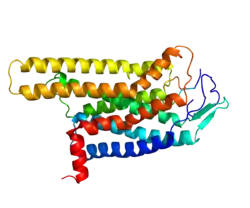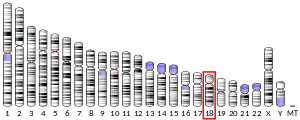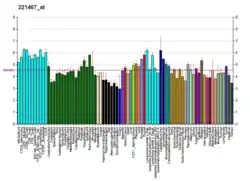Melanocortin 4 receptor (MC4R) is a melanocortin receptor that in humans is encoded by the MC4R gene.[5][6][7] It encodes the MC4R protein, a G protein-coupled receptor (GPCR) that binds α-melanocyte stimulating hormone (α-MSH). In mouse models, MC4 receptors have been found to be involved in feeding behaviour, the regulation of metabolism, sexual behaviour, and male erectile function.[8][9][10]
Clinical significance
In 2009, two very large genome-wide association studies of body mass index (BMI) confirmed the association of variants about 150 kilobases downstream of the MC4R gene with insulin resistance, obesity, and other anthropometric traits.[11][12][13][14] MC4R may also have clinical utility as a biomarker for predicting individual susceptibility to drug-induced adverse effects causing weight gain and related metabolic abnormalities. Another GWAS performed in 2012 identified twenty SNPs located ~190 Kb downstream of MC4R in association with severe antipsychotic-induced weight gain. This locus overlapped with the region previously identified in the 2009 studies. The rs489693 polymorphism, in particular, sustained a statistically robust signal across three replication cohorts and demonstrated consistent recessive effects.[15] This finding was replicated again by another research group in the following year.[16] In accordance with the above, MC4 receptor agonists have garnered interest as potential treatments for obesity and insulin resistance,[17][18] while MC4 receptor antagonists have attracted interest as potential treatments for cachexia.[19] The structures of the receptor in complex with the agonist setmelanotide[20] and the antagonist SHU9119[21] have been determined.
The MC4 receptor agonist bremelanotide (PT-141), sold under the brand name Vyleesi, was approved in the United States as a treatment for low sexual desire in women in 2019.[22] Melanotan II, a synthetic analog of α-MSH, is marketed to the general population for sexual enhancement by internet retailers.[23] PL-6983 and PF-00446687 are under investigation as potential treatments for both female and male sexual dysfunction, including hypoactive sexual desire disorder and erectile dysfunction.[24] The non-selective melanocortin receptor agonist afamelanotide (NDP-α-MSH) has been found to induce brain-derived neurotrophic factor (BDNF) expression in the rodent brain via activation of the MC4 receptor and mediate "intense" neurogenesis and cognitive recovery in an animal model of Alzheimer's disease.[25][26] MC4 receptor antagonists produce pronounced antidepressant- and anxiolytic-like effects in animal models of depression and anxiety.[27][28] And agonists of the MC4 receptor such as melanotan II and PF-00446687, via activation of the central oxytocin system, have been found to promote pair bond formation in prairie voles and, due to these prosocial effects, have been suggested as possible treatments for social deficits in autism spectrum disorders and schizophrenia.[29]
In 2008, MC4R mutations were reported to be associated with inherited human obesity.[30] They were found in heterozygotes, suggesting an autosomal dominant inheritance pattern. However, based on other research and observations, these mutations seem to have an incomplete penetrance and some degree of codominance. It has a prevalence of 1.0–2.5% in people with body mass indices greater than 30, making it the most commonly known genetic defect predisposing people to obesity.[31]
In an exome-wide meta-analysis across three cohorts (UKB,GHS and MCPS), there were 16 genes for which there genetic variants was associated with BMI.
Among the 16 genes, the analysis identified two for which rare mutations are known to cause monogenic obesity: MC4R and PCSK1 (proprotein convertase subtilisin/kexin type 1). One study provides genetic evidence linking rare coding variation to BMI and obesity-related phenotypes.
MC4R gene mutations are associated with early-onset severe obesity they effect of mutations on opacity in these two heterozygous coding genes among mutations in the MC4R gene (C293R and S94N) are:
• Rapid weight gains from early age (the most important feature).
• Development of severe obesity (BMI ≫97th percentile) at early ages, usually <3 years of age.
• Persistent food-seeking behavior, mostly reported from six months of age.
• Parental/siblings anthropometric data: suspect if relatives present normal anthropometric data.
• Tall stature/increased growth velocity (MC4R monogenic diabetes). There is limited treatment options for the most common form of monogenic obesity, MC4R mutations symptoms can be treated with a Glucagon-like Peptide-1 Receptor Agonist liraglutide which cause weight loss by reducing appetite. They found that the effects of liraglutide 3.0 mg daily for 16 weeks causes weight reducing and glucose lowering and may be relevant treatment in the most common form of monogenic obesity.
Interactions
The MC4 receptor has been shown to interact with proopiomelanocortin (POMC).[32][33] POMC is a precursor peptide pro-hormone which is cleaved into several other peptide hormones. All of the endogenous ligands of MC4 are produced by cleaving this one precursor peptide. These endogenous agonists include α-MSH, β-MSH, γ-MSH, and ACTH.
Ca2+ as a cofactor for ligand binding
GPCRs can bind a wide variety of extracellular ligands including physiological cations. Biological and pharmacological studies have previously implicated both Zn2+ and Ca2+ in the function of multiple members of the melanocortin receptor family. There is Ca2+ in the agonist-bound structure. The researches hypothesize that Ca2+ stabilizes the ligand-binding pocket and functions as an endogenous cofactor for the binding of α-MSH to MC4 receptor. Ca2+ is likely to bind when the receptor is exposed to extracellular Ca2+ concentrations (~1.2 mM in the extracellular space of the central nervous system) but might not be bound intracellularly (Ca2+ concentration: 100 nm), thus suggesting a potential regulatory role for Ca2+ in α-MSH–binding dynamics.
Signaling along the phospholipase C pathway can significantly raise the intracellular Ca2+ concentration, and this may constitute positive feedback from signaling of MC4 receptor or other receptors that result in Ca2+ flux. This discovery highlights the plasticity and multipronged regulation and control of this receptor and will aid in next-generation structure-based drug design of therapeutics for MC4R-related obesity.
Ligands
Agonists
Non-selective
- α-MSH
- β-MSH
- γ-MSH
- ACTH
- Afamelanotide
- Bremelanotide
- Melanotan II
- Modimelanotide
- Setmelanotide was approved by FDA as first-ever therapy for chronic weight management (IMCIVREE).The setmelanotide was advanced first-in-class, precision medicine that is designed to directly address the underlying cause of obesities driven by genetic deficits in the melanocortin-4 (MC4) receptor pathway.
Selective
- AZD2820
- LY-2112688
- MK-0493
- PF-00446687
- PG-931
- PL-6983
- Ro 27-3225 – also some activity at MC1
- THIQ
Antagonists
Non-selective
- Agouti-related peptide
- Agouti signalling peptide
- SHU-8914
- SHU-9005
- SHU-9119
Selective
- HS-014
- HS-024
- JKC-363
- MCL-0020
- MCL-0042 – also a serotonin reuptake inhibitor
- MCL-0129
- ML-00253764
- MPB-10
Unknown
Evolution
Paralogues[34]
See also
References
- 1 2 3 GRCh38: Ensembl release 89: ENSG00000166603 - Ensembl, May 2017
- 1 2 3 GRCm38: Ensembl release 89: ENSMUSG00000047259 - Ensembl, May 2017
- ↑ "Human PubMed Reference:". National Center for Biotechnology Information, U.S. National Library of Medicine.
- ↑ "Mouse PubMed Reference:". National Center for Biotechnology Information, U.S. National Library of Medicine.
- ↑ Magenis RE, Smith L, Nadeau JH, Johnson KR, Mountjoy KG, Cone RD (August 1994). "Mapping of the ACTH, MSH, and neural (MC3 and MC4) melanocortin receptors in the mouse and human". Mammalian Genome. 5 (8): 503–8. doi:10.1007/BF00369320. PMID 7949735. S2CID 24047677.
- ↑ Sundaramurthy D, Campbell DA, Leek JP, Markham AF, Pieri LF (November 1998). "Assignment of the melanocortin 4 receptor (MC4R) gene to human chromosome band 18q22 by in situ hybridisation and radiation hybrid mapping". Cytogenetics and Cell Genetics. 82 (1–2): 97–8. doi:10.1159/000015074. PMID 9763669. S2CID 21946787.
- ↑ "Entrez Gene: MC4R melanocortin 4 receptor".
- ↑ Fan W, Boston BA, Kesterson RA, Hruby VJ, Cone RD (January 1997). "Role of melanocortinergic neurons in feeding and the agouti obesity syndrome". Nature. 385 (6612): 165–8. Bibcode:1997Natur.385..165F. doi:10.1038/385165a0. PMID 8990120. S2CID 4304297.
- ↑ Huszar D, Lynch CA, Fairchild-Huntress V, Dunmore JH, Fang Q, Berkemeier LR, et al. (January 1997). "Targeted disruption of the melanocortin-4 receptor results in obesity in mice". Cell. 88 (1): 131–41. doi:10.1016/S0092-8674(00)81865-6. PMID 9019399. S2CID 14528879.
- ↑ Van der Ploeg LH, Martin WJ, Howard AD, Nargund RP, Austin CP, Guan X, et al. (August 2002). "A role for the melanocortin 4 receptor in sexual function". Proceedings of the National Academy of Sciences of the United States of America. 99 (17): 11381–6. Bibcode:2002PNAS...9911381V. doi:10.1073/pnas.172378699. PMC 123265. PMID 12172010.
- ↑ Chambers JC, Elliott P, Zabaneh D, Zhang W, Li Y, Froguel P, et al. (June 2008). "Common genetic variation near MC4R is associated with waist circumference and insulin resistance". Nature Genetics. 40 (6): 716–8. doi:10.1038/ng.156. PMID 18454146. S2CID 12331736.
- ↑ Loos RJ, Lindgren CM, Li S, Wheeler E, Zhao JH, Prokopenko I, et al. (June 2008). "Common variants near MC4R are associated with fat mass, weight and risk of obesity". Nature Genetics. 40 (6): 768–75. doi:10.1038/ng.140. PMC 2669167. PMID 18454148.
- ↑ Thorleifsson G, Walters GB, Gudbjartsson DF, Steinthorsdottir V, Sulem P, Helgadottir A, et al. (January 2009). "Genome-wide association yields new sequence variants at seven loci that associate with measures of obesity". Nature Genetics. 41 (1): 18–24. doi:10.1038/ng.274. PMID 19079260. S2CID 764409.
- ↑ Willer CJ, Speliotes EK, Loos RJ, Li S, Lindgren CM, Heid IM, et al. (January 2009). "Six new loci associated with body mass index highlight a neuronal influence on body weight regulation". Nature Genetics. 41 (1): 25–34. doi:10.1038/ng.287. PMC 2695662. PMID 19079261.
- ↑ Malhotra AK, Correll CU, Chowdhury NI, Müller DJ, Gregersen PK, Lee AT, et al. (September 2012). "Association between common variants near the melanocortin 4 receptor gene and severe antipsychotic drug-induced weight gain". Archives of General Psychiatry. 69 (9): 904–12. doi:10.1001/archgenpsychiatry.2012.191. PMC 4166499. PMID 22566560.
- ↑ Czerwensky F, Leucht S, Steimer W (October 2013). "MC4R rs489693: a clinical risk factor for second generation antipsychotic-related weight gain?". The International Journal of Neuropsychopharmacology. 16 (9): 2103–9. doi:10.1017/S1461145713000849. PMID 23920449.
- ↑ Wikberg JE, Mutulis F (April 2008). "Targeting melanocortin receptors: an approach to treat weight disorders and sexual dysfunction". Nature Reviews. Drug Discovery. 7 (4): 307–23. doi:10.1038/nrd2331. PMID 18323849. S2CID 22103245.
- ↑ Fosgerau K, Raun K, Nilsson C, Dahl K, Wulff BS (February 2014). "Novel α-MSH analog causes weight loss in obese rats and minipigs and improves insulin sensitivity". The Journal of Endocrinology. 220 (2): 97–107. doi:10.1530/JOE-13-0284. PMC 3888513. PMID 24204009.
- ↑ Foster AC, Chen C (2007). "Melanocortin-4 receptor antagonists as potential therapeutics in the treatment of cachexia". Current Topics in Medicinal Chemistry. 7 (11): 1131–6. doi:10.2174/156802607780906663. PMID 17584133. S2CID 35953386.
- ↑ Israeli H, Degtjarik O, Fierro F, Chunilal V, Gill AK, Roth NJ, et al. (May 2021). "Structure reveals the activation mechanism of the MC4 receptor to initiate satiation signaling". Science. 372 (6544): 808–814. Bibcode:2021Sci...372..808I. doi:10.1126/science.abf7958. PMID 33858992. S2CID 233260097.
- ↑ Yu J, Gimenez LE, Hernandez CC, Wu Y, Wein AH, Han GW, et al. (April 2020). "Determination of the melanocortin-4 receptor structure identifies Ca2+ as a cofactor for ligand binding". Science. 368 (6489): 428–433. Bibcode:2020Sci...368..428Y. doi:10.1126/science.aaz8995. PMC 7567314. PMID 32327598.
- ↑ "Bremelanotide Acetate Monograph for Professionals". Drugs.com.
- ↑ Evans-Brown M, Dawson RT, Chandler M, McVeigh J (February 2009). "Use of melanotan I and II in the general population". BMJ. 338: b566. doi:10.1136/bmj.b566. PMID 19224885. S2CID 43121906.
- ↑ Shadiack AM, Sharma SD, Earle DC, Spana C, Hallam TJ (2007). "Melanocortins in the treatment of male and female sexual dysfunction". Current Topics in Medicinal Chemistry. 7 (11): 1137–44. doi:10.2174/156802607780906681. PMID 17584134.
- ↑ Giuliani D, Neri L, Canalini F, Calevro A, Ottani A, Vandini E, et al. (July 2015). "NDP-α-MSH induces intense neurogenesis and cognitive recovery in Alzheimer transgenic mice through activation of melanocortin MC4 receptors". Molecular and Cellular Neurosciences. 67: 13–21. doi:10.1016/j.mcn.2015.05.004. hdl:11380/1067772. PMID 26003413. S2CID 22132459.
- ↑ Ramírez D, Saba J, Carniglia L, Durand D, Lasaga M, Caruso C (August 2015). "Melanocortin 4 receptor activates ERK-cFos pathway to increase brain-derived neurotrophic factor expression in rat astrocytes and hypothalamus". Molecular and Cellular Endocrinology. 411: 28–37. doi:10.1016/j.mce.2015.04.008. hdl:11336/15275. PMID 25892444. S2CID 20727709.
- ↑ Serova LI, Laukova M, Alaluf LG, Sabban EL (August 2013). "Intranasal infusion of melanocortin receptor four (MC4R) antagonist to rats ameliorates development of depression and anxiety related symptoms induced by single prolonged stress". Behavioural Brain Research. 250: 139–47. doi:10.1016/j.bbr.2013.05.006. PMID 23680165. S2CID 25321970.
- ↑ Chaki S, Okubo T (2007). "Melanocortin-4 receptor antagonists for the treatment of depression and anxiety disorders". Current Topics in Medicinal Chemistry. 7 (11): 1145–51. doi:10.2174/156802607780906618. PMID 17584135.
- ↑ Modi ME, Inoue K, Barrett CE, Kittelberger KA, Smith DG, Landgraf R, Young LJ (July 2015). "Melanocortin Receptor Agonists Facilitate Oxytocin-Dependent Partner Preference Formation in the Prairie Vole". Neuropsychopharmacology. 40 (8): 1856–65. doi:10.1038/npp.2015.35. PMC 4839509. PMID 25652247.
- ↑ Loos RJ, Lindgren CM, Li S, Wheeler E, Zhao JH, Prokopenko I, et al. (June 2008). "Common variants near MC4R are associated with fat mass, weight and risk of obesity". Nature Genetics. 40 (6): 768–75. doi:10.1038/ng.140. PMC 2669167. PMID 18454148.
- ↑ Farooqi S, O'Rahilly S (December 2006). "Genetics of obesity in humans". Endocrine Reviews. 27 (7): 710–18. doi:10.1210/er.2006-0040. PMID 17122358.
- ↑ Yang YK, Fong TM, Dickinson CJ, Mao C, Li JY, Tota MR, et al. (December 2000). "Molecular determinants of ligand binding to the human melanocortin-4 receptor". Biochemistry. 39 (48): 14900–11. doi:10.1021/bi001684q. PMID 11101306.
- ↑ Yang YK, Ollmann MM, Wilson BD, Dickinson C, Yamada T, Barsh GS, Gantz I (March 1997). "Effects of recombinant agouti-signaling protein on melanocortin action". Molecular Endocrinology. 11 (3): 274–80. doi:10.1210/mend.11.3.9898. PMID 9058374.
- ↑ "GeneCards®: The Human Gene Database".
Further reading
- Mountjoy KG, Mortrud MT, Low MJ, Simerly RB, Cone RD (October 1994). "Localization of the melanocortin-4 receptor (MC4-R) in neuroendocrine and autonomic control circuits in the brain". Molecular Endocrinology. 8 (10): 1298–308. doi:10.1210/mend.8.10.7854347. PMID 7854347. S2CID 32709901.
- Gantz I, Miwa H, Konda Y, Shimoto Y, Tashiro T, Watson SJ, et al. (July 1993). "Molecular cloning, expression, and gene localization of a fourth melanocortin receptor". The Journal of Biological Chemistry. 268 (20): 15174–9. doi:10.1016/S0021-9258(18)82452-8. PMID 8392067.
- Alvaro JD, Tatro JB, Quillan JM, Fogliano M, Eisenhard M, Lerner MR, et al. (September 1996). "Morphine down-regulates melanocortin-4 receptor expression in brain regions that mediate opiate addiction". Molecular Pharmacology. 50 (3): 583–91. PMID 8794897.
- Yang YK, Ollmann MM, Wilson BD, Dickinson C, Yamada T, Barsh GS, Gantz I (March 1997). "Effects of recombinant agouti-signaling protein on melanocortin action". Molecular Endocrinology. 11 (3): 274–80. doi:10.1210/mend.11.3.9898. PMID 9058374.
- Chagnon YC, Chen WJ, Pérusse L, Chagnon M, Nadeau A, Wilkison WO, Bouchard C (October 1997). "Linkage and association studies between the melanocortin receptors 4 and 5 genes and obesity-related phenotypes in the Québec Family Study". Molecular Medicine. 3 (10): 663–73. doi:10.1007/BF03401705. PMC 2230227. PMID 9392003.
- Yeo GS, Farooqi IS, Aminian S, Halsall DJ, Stanhope RG, O'Rahilly S (October 1998). "A frameshift mutation in MC4R associated with dominantly inherited human obesity". Nature Genetics. 20 (2): 111–2. doi:10.1038/2404. PMID 9771698. S2CID 7287831.
- Vaisse C, Clement K, Guy-Grand B, Froguel P (October 1998). "A frameshift mutation in human MC4R is associated with a dominant form of obesity". Nature Genetics. 20 (2): 113–4. doi:10.1038/2407. PMID 9771699. S2CID 40193066.
- Hinney A, Schmidt A, Nottebom K, Heibült O, Becker I, Ziegler A, et al. (April 1999). "Several mutations in the melanocortin-4 receptor gene including a nonsense and a frameshift mutation associated with dominantly inherited obesity in humans". The Journal of Clinical Endocrinology and Metabolism. 84 (4): 1483–6. doi:10.1210/jcem.84.4.5728. PMID 10199800.
- Yang YK, Dickinson CJ, Zeng Q, Li JY, Thompson DA, Gantz I (May 1999). "Contribution of melanocortin receptor exoloops to Agouti-related protein binding". The Journal of Biological Chemistry. 274 (20): 14100–6. doi:10.1074/jbc.274.20.14100. PMID 10318826.
- Ho G, MacKenzie RG (December 1999). "Functional characterization of mutations in melanocortin-4 receptor associated with human obesity". The Journal of Biological Chemistry. 274 (50): 35816–22. doi:10.1074/jbc.274.50.35816. PMID 10585465.
- Yang YK, Fong TM, Dickinson CJ, Mao C, Li JY, Tota MR, et al. (December 2000). "Molecular determinants of ligand binding to the human melanocortin-4 receptor". Biochemistry. 39 (48): 14900–11. doi:10.1021/bi001684q. PMID 11101306.
- Mergen M, Mergen H, Ozata M, Oner R, Oner C (July 2001). "A novel melanocortin 4 receptor (MC4R) gene mutation associated with morbid obesity". The Journal of Clinical Endocrinology and Metabolism. 86 (7): 3448. doi:10.1210/jcem.86.7.7809. PMID 11443223.
- McNulty JC, Thompson DA, Bolin KA, Wilken J, Barsh GS, Millhauser GL (December 2001). "High-resolution NMR structure of the chemically-synthesized melanocortin receptor binding domain AGRP(87-132) of the agouti-related protein". Biochemistry. 40 (51): 15520–7. CiteSeerX 10.1.1.522.4019. doi:10.1021/bi0117192. PMID 11747427.
- Brocke KS, Neu-Yilik G, Gehring NH, Hentze MW, Kulozik AE (February 2002). "The human intronless melanocortin 4-receptor gene is NMD insensitive". Human Molecular Genetics. 11 (3): 331–5. doi:10.1093/hmg/11.3.331. PMID 11823452.
- Yang Y, Chen M, Lai Y, Gantz I, Georgeson KE, Harmon CM (June 2002). "Molecular determinants of human melanocortin-4 receptor responsible for antagonist SHU9119 selective activity". The Journal of Biological Chemistry. 277 (23): 20328–35. doi:10.1074/jbc.M201343200. PMID 11912210.
- Hansen MJ, Morris MJ (May 2002). "Evidence for an interaction between neuropeptide Y and the melanocortin-4 receptor on feeding in the rat". Neuropharmacology. 42 (6): 792–7. doi:10.1016/S0028-3908(02)00025-4. PMID 12015205. S2CID 29068487.
- Miraglia Del Giudice E, Cirillo G, Nigro V, Santoro N, D'Urso L, Raimondo P, et al. (May 2002). "Low frequency of melanocortin-4 receptor (MC4R) mutations in a Mediterranean population with early-onset obesity". International Journal of Obesity and Related Metabolic Disorders. 26 (5): 647–51. doi:10.1038/sj.ijo.0801983. PMID 12032748.
- Kim CS, Lee SH, Kim RY, Kim BJ, Li SZ, Lee IH, et al. (August 2002). "Identification of domains directing specificity of coupling to G-proteins for the melanocortin MC3 and MC4 receptors". The Journal of Biological Chemistry. 277 (35): 31310–7. doi:10.1074/jbc.M112085200. PMID 12045190.
External links
- "Melanocortin Receptors: MC4". IUPHAR Database of Receptors and Ion Channels. International Union of Basic and Clinical Pharmacology.
This article incorporates text from the United States National Library of Medicine, which is in the public domain.





